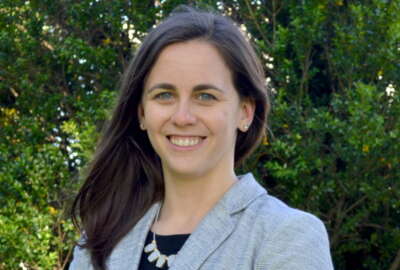Energy Department widens the hunt for novel energy technologies
The Advanced Research Projects Agency Energy launched a $175 million grant program for everything from wind to fusion.
Best listening experience is on Chrome, Firefox or Safari. Subscribe to Federal Drive’s daily audio interviews on Apple Podcasts or PodcastOne.
The Advanced Research Projects Agency Energy (ARPA-E) is spending big to unearth the next generation of technologies for energy. It’s launched a $175 million grant program for everything from wind to fusion. For details, ARPA-E’s Deputy Director for Technology, Dr. Jenny Gerbi, spoke to the Federal Drive with Tom Temin.
Interview transcript:
Tom Temin: Dr. Gerbi, good to have you here in studio.
Jennifer Gerbi: Good to be here.
Tom Temin: Alright, so let’s begin with this advanced energy enterprise that you describe in this program. What exactly is that, within the context of the department?
Jennifer Gerbi: ARPA-E is a very interesting place in that we have the freedom to look into what problems should be solved and why? We don’t have some roadmap that tells us what to do and how much money we have to spend on things. So we bring a core of people into the agency and from the bottom up, decide what needs to be done. And this is a very pragmatic thing. And it’s also very optimistic thing. So it can be anything like you mentioned, fusion, two completely new ways of doing fusion, which is way out there, to new fuels and things you could use tomorrow, if they worked. So it’s really looking at that entire space of how you would use something and make something but also tech that just doesn’t exist yet.
Tom Temin: It strikes me that the one hand, the problems easy to state go to all green or all renewable energy, if that’s your bent, or no fossil fuels. But the hard part is enough power and reliable power, because it’s easy to go 100% green, but we may not like it when it comes out. So is that part of the thinking?
Jennifer Gerbi: That’s a really good point. Because it really comes down to how people behave and what they need to use. And we see all options on the table. So thinking about 100%, renewable, what does that really mean? You have to think about it in terms of carbon and the lifecycle of things. So if you could make fuels that mimic gasoline, but that are made and even a carbon negative way, why wouldn’t you use it? So you have to respect the infrastructure that’s there, and realize that you know what, multiple solutions might fit in this space. Yes we could go to 100% wind and solar, let’s say, but then you have a lot of issues with the grid. And so grid storage ends up being a really key issue. So we don’t choose winners, we look at multiple paths to solve problems, and they’re not in competition with each other.
Tom Temin: Sounds like you take almost a systems view of the whole energy enterprise, if you will?
Jennifer Gerbi: Yeah.
Tom Temin: Alright, let’s talk about this grant program. That’s a lot of money, even by federal grant program standards. Sometimes there are, 10 people get $10,000. Here, you’ve got 175 million. Let’s talk about the range of types of energy sources that you would consider eligible here. Let’s start there.
Jennifer Gerbi: Sure. So the open program is really unique for us. We do it every three years. And this is a chance for everybody else out there to tell us what we should be doing, and for their tech to be able to fulfill our mission. And it’s all about our mission. And our mission is super broad. It’s basically solving energy problems for the country. So there could be technologies all over the map. Again, some of the things that I just mentioned, we have some fusion projects in this open program. We have battery projects, we have fuel projects, we have capping oil well projects, I mean, it’s all over the map. And I think that’s really important because it helps the agency understand what’s out there, what we might not be doing programs and now. And I’ll emphasize, it’s actually not a grant program, we do cooperative agreements, which means they can change, they can stop, they can grow, we actively manage these portfolios. And that’s something that’s a little bit unique to us.
Tom Temin: So they’re not exactly acquisition contracts. They’re not exactly grants, but there’s some hybrid way of dealing with the outside sector.
Jennifer Gerbi: That’s right. We’ll have milestones, we’ll have goals, we know things sometimes have to change. Sometimes a group does amazing work and shows something’s impossible. We say thank you so much, write it up, and then we actually stop the funding.
Tom Temin: So in some ways that fulfills something that a lot of people in government often say should be done, but often isn’t because of whatever, lethargy or fear, but that is countenancing failure, that is to try things and well, it didn’t work out, but at least now we know.
Jennifer Gerbi: Exactly. And you know, that’s one of the reasons why this country has such a strong innovation culture is because we are not afraid to fail. We are not afraid to take chances. And the thing is, if that is in your mission, if upfront you know that that’s going to be the case and you accept that level of risk, then you can do these things. And that’s why the agency needs to be set up the way it is. And we’re very lucky to have the freedom to be able to do this in the right way. And the people that set up the agency knew exactly what they were doing to enable that to happen. So you take 15 shots on goal, that goal seems almost impossible. If two of those shots work, that’s amazing, that’s disruptive, and it has formed a whole new pathway of being able to get things done. So that’s what we do.
Tom Temin: Yeah, I hear the new Caps coach coming, maybe, if things don’t work out this season? And what types of enterprises do you have these cooperative agreements with? Both for-profit and not-for-profit?
Jennifer Gerbi: That’s right, almost anybody so we will have small little startups, large companies, national labs, academic groups, and combinations of all of them. It really depends on the project itself and the program and it’s a challenge for us because in the same program trying to solve one problem, let’s just say, you can have 15 projects, and again, one might be a GE, and one might be a startup that has three people in it.
Tom Temin: We’re speaking with Dr. Jenny Gerbi, she’s deputy director for technology at the Advanced Research Projects Agency-Energy (ARPA-E). And let’s talk about some of the grand challenges here. And I want to ask about two. When I was a kid, and maybe even since then, fusion was always something that was like “The Jetsons.” It’s a fantasy, it’ll be 200 years ’til we have fusion energy, as opposed to fission energy. What’s the status of fusion and sounds like you sense that it could be at hand?
Jennifer Gerbi: Isn’t George Jetson supposed to be born later this year or something like that, anyway? Yeah, agreed. Fusion is really exciting, because there have been a lot of advances throughout the years, and there’s been a lot of very large efforts towards getting the science to happen. But when you look at it from a techno economic point of view, you could say, you know what, even if that works, that’s amazing. But it doesn’t make sense financially, to move it forward in the right way. So we need other ways of doing this. So that’s why ARPA-E has been involved in fusion, which is a small amount of money compared to other money going into fusion, because we’re looking at what are other routes? What are other ways to actually make this more feasible from a techno economic point of view. So there have been a lot of advances in fusion. The DOE, I think is very excited about this. I think the White House is very excited about this. And I wouldn’t say it’s at hand. But from a science point of view, when you look at the advances, it’s really starting to look compelling. And people sometimes think fusion is a black and white thing. It’s like, oh, all of a sudden, it’s now breakeven, and it solves all the problems. It’s like, no, it’s on a path just like anything else. But it’s one of the things that we’re excited about. But again, one of the many things.
Tom Temin: If someone says too cheap to meter, like they said in 1950 about atomic don’t listen to them. And my other question is batteries, because for many years, there have been steady improvements in existing battery technology, more density. But then we saw a whole shipload of luxury electric cars caught fire and sank in the middle of the ocean. So there are issues with current battery technology. So the word is that you hear we need the next generation of technology for battery. And that’s a really tough breakthrough, because that’s chemistry and chemistry produces a certain amount of current and voltage. That’s a law of nature, almost. So what do you see ahead for battery technology, which is part of your program?
Jennifer Gerbi: It is, we have multiple programs in batteries, I would say. And one of those things is looking at solid ion conductors. I mean, the reason batteries are flammable is because they have this liquid electrolyte in them that’s very flammable. If you can get rid of that, you can have a much safer battery. But it’s also looking at different battery chemistries. There’s issues with getting enough materials for batteries. If we all want to have batteries, then that means a lot of certain materials, we look at alternative chemistries, chemistries that enable batteries to charge super fast. That’s something that a lot of people with electric cars would like to have. And it’s not the charger that’s the limit. It’s the battery, that’s the limit. So there’s actually a lot of science and engineering that can go on in batteries. But again, that field’s been around for a long time. So this stuff is considered very high risk by the people who are making batteries, which is one of the reasons why we’re involved in it, because we’re doing some things that other people aren’t doing.
Tom Temin: So it sounds like you’re looking for two things, one, incremental changes and improvements in existing technologies, because those are always needed, but also the next step function in new technology or some kind of breakthrough.
Jennifer Gerbi: That’s right. So ARPA-E does the second. There’s other parts of the DoD that look at improving the current technologies that we have, which is really important and constantly needs to be done. So we sort of fill in the space that is too risky for other folks to do, whether it is government funding or private funding. So we work on things that other people don’t.
Tom Temin: Alright, tell us then about the program parameters, here: Who can apply? When can they apply? And how does the whole thing work from a calendar standpoint?
Jennifer Gerbi: We put out a lot of different programs throughout the years. And there’s also different types of programs. There’s something called the ARPA-E exchange site, which you should go and look on there. And that’s where we release everything. So sometimes we release a sort of a call for information, we ask questions, we want to get your feedback in terms of what a future program might be. That’s where we put out the funding solicitations where you apply to get funding. And we have these different focus programs constantly all the time. Again, this big open FOA [Funding Opportunity Announcement] that we’re just talking about that goes out once every three years. It takes a full year for us to actually go through and do the work of getting to the selections. So there should be another one in two years. But we also have another program called scale up which is about funding previously funded ARPA-E technologies to get them to the next step. So everything shows up on that exchange site and we even have it open right now actually, an [Small Business Innovation Research]-only little seedling FOA, which are $500,000 grants, not cooperative agreements, for SBIR companies.
Tom Temin: All right, so if you have an idea, get in on it.
Jennifer Gerbi: Yes.
Tom Temin: Dr. Jenny Gerbi is deputy director for Technology at the Advanced Research Projects Agency-Energy. Thanks so much for joining me.
Jennifer Gerbi: Thank you.
Copyright © 2025 Federal News Network. All rights reserved. This website is not intended for users located within the European Economic Area.
Tom Temin is host of the Federal Drive and has been providing insight on federal technology and management issues for more than 30 years.
Follow @tteminWFED






